- 0 Καλάθι Αγορών
-
ΤΟ ΚΑΛΑΘΙ ΑΓΟΡΩΝ ΣΑΣ ΕΙΝΑΙ ΑΔΕΙΟ
-
Chario Academy Sovran loudspeaker
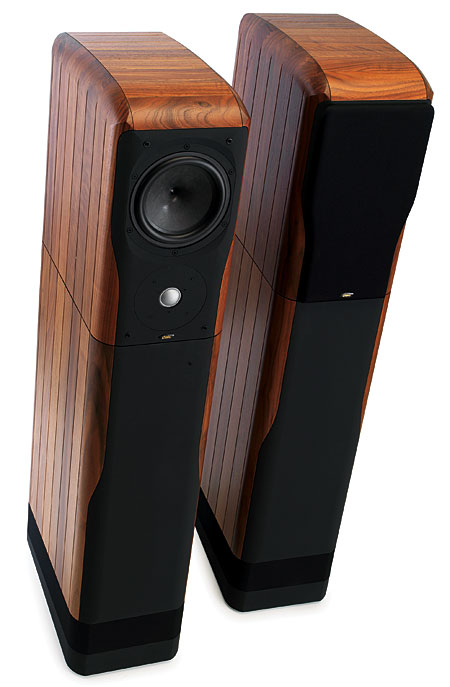
In short, Chario is a veteran Italian speaker manufacturer with a long history of innovation. Still, Chario's new US importer, Puerto Rico–based Koetsu USA, is facing a challenge in getting that point across in the crowded American loudspeaker market. They offered for review the Sovran, a brand-new model in Chario's top line, the Academy series, hoping its relatively modest price (for a high-performance speaker) of $17,000/pair would do just that.
Three-Way, Two-Box Design
The Sovran is just under the top model of Chario's Academy series, the Serendipity. The new speaker comprises two cabinets. On top is a two-way box of solid walnut or cherry with a front baffle of high-density fiberboard (HDF), containing a 1.2" Silversoft soft-dome tweeter that fires at a (seated) ear height of 35", and above it a 6.7" Rohacell Full-Apex Poly-Ring mid/woofer. This is loaded with a slot that fires to the rear.
Below this sits the subwoofer tower, decoupled from the upper cabinet with four proprietary circular elastomer "puffers" that fit inside cylindrical recesses machined into both boxes. Inside the isobarically loaded woofer box, close to the floor and a little more than 1m away from the upper box's mid/woofer, are two vertically arrayed 8" natural-fiber drivers configured "cone to cone." These are wired out of phase with each other so that the two cones move as one.
The motors of all drive-units are based on neodymium magnets. WBT speaker terminals—two pairs on the subwoofer tower, one pair on the woofer/tweeter cabinet—allow biamping as well as standard hookup via a supplied set of jumpers. The Academy Sovran's exquisite woodworking and overall design meet the highest expectations for an Italian-made loudspeaker. The speaker's size and shape (48" tall by 9.5" wide by 17" deep) makes it ideal for rooms of small to medium size.
In a booklet accompanying the Sovran, Mario Marcello Murace, an electrical engineer and Chario's head of research and development, provides an unusually detailed technical explanation of the speaker's design. Unfortunately, the cumbersome translation renders incomprehensible many concepts that, to begin with, are difficult to grasp. This is not helped by Chario's penchant for trademarking terms it then fails to define.
A careful reading of the booklet indicates that Murace has attempted to keep parallel the phase-delay slopes of the crossovers between the subwoofer and mid/woofer and the mid/woofer and tweeter, in order to produce uniform off-axis performance. This, he claims, lets you toe the speakers in for greater soundstage depth, or fire them straight ahead for a soundstage wider than the distance between the cabinets, without affecting the Sovrans' reproduction of timbres.
Murace also claims that the relatively large distance between the floor-hugging subwoofers and the mid/woofer, combined with a crossover network that produces a large overlap of frequencies, extending from 80 to 250Hz, reduces the effects of room modes that lead to low-frequency peaks and dips, and diminishes a spaciousness-reducing phenomenon Murace describes as bass mono effect, caused by the similarity of direct and reflected low-frequency energy in a small room.
Much of the technical description, while useful, is incomprehensible and should be rewritten. In the end, what matters is the sound. But even a fuzzy understanding of Murace's design goals for the Sovran helped explain why these speakers were unusually easy to position in my room.
Setup
Moving the Academy Sovrans around the area of my room where most speakers have performed best produced the fewest shifts of bass quality and timbral accuracy I've ever heard. The Sovrans were the least fussy speakers I've ever set up in my current room.
Likewise, whether set up toed-in or firing straight ahead, the Sovrans' tonal balance remained remarkably consistent. Only their spatial performance changed, as described in the manual. Toed-in, they produced a deeper but somewhat narrower soundstage; with their side panels parallel to the room's sidewalls, the stage widened, opening up to extend beyond the baffles, but wasn't as deep.
Ultimately, I preferred the Charios toed-in. I lined up their front baffles along the marks that describe the positions of my reference speakers, the Wilson Audio Specialties MAXX 2s. Based on my experience, I'd say that if you can afford the Sovrans, they'd be a better bet than most to perform well in situations where speaker-placement options are few.
Hardly romantic sound
Most audiophiles associate Italian loudspeakers with a warm, romantic sound, their appeal being more to the heart than to the head. But nothing about the Sovran's timbral balance or overall sound induced me to swoon, nor do I think designer Mario Marcello Murace intended it to. Despite the Sovran's looks, its sound was more Teutonic than typically Italianate. With the speaker's claimed –3dB low-frequency cutoff point of 35Hz, I wasn't expecting to hear ultradeep bass, and I didn't. But the bass the Sovran did produce sounded nonmechanical, natural, and as musically accurate as I've heard from any speaker at any price.
The bottom octaves were exceedingly clean and nimble. While 35Hz can't give you the full bottom weight, the Sovran more than compensated with clarity and ultralow coloration, which are easily preferable to greater bass extension that comes at the price of bloat, overhang, and detail-obscuring warmth.
The Sovran's complete freedom from midbass overhang meant that, until I got used to the speaker's clarity and honesty in the lower octaves, I had to check to make sure the woofers were working, because they were impossible to "hear." When called on to produce deep bass, they did. When not, they shut up.
The Sovran's integration of its bass, midbass, and midrange outputs was also subjectively seamless, producing spectacular resolution of "event detail" with individual instruments. Voices, especially, "popped" brilliantly in three-dimensional space, and were never obscured by "warm" zones. The handoff from the mid/woofer to the tweeter, which according to a graph in the manual occurs at an unusually low 1180Hz, was also smooth and impressively transparent. Not surprisingly, male and female voices sounded pleasingly coherent and fundamentally correct.
It's always fun to hear a new tweeter, and Chario's Silversoft dome proved highly resolving, ultradetailed, and "fast." If the Focal 1037 Be's inverted beryllium-dome tweeter sounded on the warm, smooth, burnished side of detailed, Chario's was on the airy, exuberant side—much like Dynaudio's famed Esotar tweeter.
All together, I heard a tonal balance that was predicted with remarkable accuracy by the frequency response graph printed in the Sovran's manual. According to that plot, the speaker rolls off steeply below 35Hz and is remarkably smooth through the midbass. A dip beginning at around 800Hz extends up to about 4kHz, with then a rising response up to 8kHz, followed by another slight dip, and then by a peak at around 15kHz.
The Sovran's overall timbral balance was on the lean and cool side of neutral, but just slightly so—the kind of smooth, measured tonal balance that's easy to fine-tune to neutrality with accessories and good choices of associated gear.
Driven by the warm, smooth, detailed Luxman M-800A power amp (see my review in the November issue), or the Music Reference RM-200, the Chario Sovran produced a nearly ideal tonal balance with just a slight, smooth glisten on top, whether the speakers were toed-in or firing straight ahead. Driven by the Musical Fidelity kW monoblocks, they sounded a bit cooler than ideal, but the combination still made for pleasing, exciting listening.
While a number of other speakers have matched the Academy Sovran's impressive timbral neutrality, few at any price have managed the believability of its reproduction, even straight out of their crates, of the sounds of musical instruments. I didn't hear music pouring forth from a pair of boxes, nor did instruments within a given frequency range sound tied together in a "frequency zone." There were no zones of warmth or coolness through which I had to listen to reach the instruments. The Sovran was one of the least colored speakers I've heard, with an addictive immediacy and vibrancy to its presentation.
Julie London's Julie Is Her Name (45rpm LPs, Liberty/BoxStar) produced a mesmerizing combination of vocal detail and instrumental clarity. The Sovrans presented London's voice vividly in three-dimensional space with sufficient presence and resolution to be believable without sounding over-analyzed. Barney Kessel's guitar comping produced effervescent rhythmic zip, as well as delicacy and harmonic and textural complexity. A test pressing of a new Warner Bros. reissue on vinyl of Van Morrison's cosmic Astral Weeks revealed the Sovrans' ability to present images super-cleanly in space and make the speaker baffles seem to disappear. The delicate finger cymbals on "Sweet Thing" floated as tangible crystalline presences well in front of the baffles, their decays trailing off for what seemed impossibly long times.
If you like a warm, fuzzy, comfortable sound, the Chario Sovran might not be for you. If you like a tightly sprung ride with great clarity of attack, clean sustain, and long decays that glorify great recordings, the Academy Sovran will give you all that and more. But be prepared: this speaker gives problematic recordings nowhere to hide their junk.
Though not a large speaker, the Sovran could play loudly without strain, and maintained its clarity and cohesiveness with equal competence at the level of a whisper. Instruments maintained their timbral and physical integrities, and their images were placed well clear of the baffles at high, low, or medium SPLs.
If I had to sum up the Sovran in a single phrase, it would be "well organized." It spoke with one voice, rhythmically, harmonically, and dynamically, and produced sonic pictures that sounded as if produced by a pulsating sphere—more so than even Cabasse's La Sphère, which is a sphere. It was as if the sound were being launched from a single point.
Reference Recordings recently released Tutti!, a sampler of spectacular-sounding orchestral recordings from its catalog (SACD/CD, RR-906SACD). This sort of musical fireworks display has been a staple of audiophiledom since the 1950s, and Tutti! delivers the goods with such familiar sonic blockbusters as Rimsky-Korsakov's Dance of the Tumblers (from The Snow Maiden) and Mussorgsky's Great Gate at Kiev (from Pictures at an Exhibition), both with Eiji Oue conducting the Minnesota Orchestra. While the Sovrans couldn't match the Wilson MAXX 2s' massive attack or depth-charge bass punch, they did reproduce different but equally impressive facsimiles of these Prof. Keith Johnson recordings that were more compact, tightly drawn, and spatially coherent, particularly in terms of soundstage depth and the clean separation of individual instruments.
The Sovran did rock and jazz as well as, if not better than, it did classical (which was plenty good), where ultradeep bass is more important. (You might be surprised by how little bass there is below 35Hz in most rock and jazz recordings.) The Sovran shone on such well-recorded rock albums as Elvis Costello's Trust (LP, F-Beat XX11LP). The cymbals shimmered brilliantly, the snare popped, and the drum kit appeared tightly focused in space. Steve Nieve's piano produced a pleasing sparkle above the instrument's harmonic envelope, without ever hardening or turning brittle. Costello's voice floated convincingly between the speakers, fully fleshed out, each ironic inflection communicated with great clarity.
Hearing the 45rpm reissue of the Bill Evans Trio's Waltz for Debby (LPs, Analogue Productions) through the Charios was a real treat. The Sovrans placed me in the Village Vanguard, close to the stage. Paul Motian's cymbal work produced brilliant shimmer, palpable textures, and a lot of air. I could feel Scott LaFaro's bass plucks, the weight of the instrument, and its tightly defined image in space. Evans' piano combined a complex percussive attack, a woody-metallic sustain, and delicate decays that lasted even as the notes piled up. Time and tonal smear were thankfully missing in action—a difficult feat with this recording. Few speakers manage it so well.
Visiting audiophiles, novices and veterans alike, were impressed by the Sovrans' lack of obvious colorations, their rhythmic snap, their spatial coherence and three-dimensionality, and especially their effervescence—these speakers' ability to quickly conjure up and make vanish musical moments in time. So was I.
Conclusions
Elegantly conceived and beautifully built, Chario's Academy Sovran offers a high level of sonic performance in every possible category except the deepest bass—and what it lacks in that department it more than makes up for with the high quality of the pitch-perfect bass it does produce.
The Sovran impressed me most with its rock-solid rhythmic coherence and its clean, nimble attack, followed by its smooth tonal balance. Add to that its solid imaging and impressive soundstaging—depending on the speaker positions, you have a choice of a deep, narrow soundstage or one that's a lot wider and a bit shallower, but with consistent reproduction of timbres either way. Add to that the meticulously finished cabinets of solid hardwood, exceptional resolution of high-frequency detail with only a slight tilt toward brightness, and you have a speaker that, while not inexpensive, offers exceptional performance with fit'n'finish to match. But equally impressive was what I didn't hear from the Sovran: bloat, false warmth, etch, grain, or—especially—congestion.
The US loudspeaker market may be overcrowded, but there's always room for a speaker as well designed and executed as the Chario Academy Sovran. It challenges anything else in its price class, and many speakers costing far more.
Sidebar 1: Specifications
Description: Three-way, floorstanding loudspeaker. Drive-units: 1.2" (32mm) Silversoft tweeter, 6.7" (170mm) aperiodically loaded Rohacell cone mid/woofer, two 8" (200mm) isobarically loaded woofers. Frequency range: 35Hz–20kHz. Nominal impedance: 4 ohms. Sensitivity: 90dB/2.83V/m. Recommended amplification: 180W into 4 ohms.
Dimensions: 47.6" (1220mm) H by 9.4" (240mm) W by 17.2" (440mm) D. Weight: 103.4 lbs (47kg).
Finishes: Solid walnut or cherry.
Serial Numbers Of Units Reviewed: 65159, 65160.
Price: $17,000/pair. (στην Ελλαδα λιανικη μονο 8500 ευρω το ζευγος)
Chario Academy Sovran loudspeaker Measurements
The Chario Academy Sovran's voltage sensitivity is specified as a high 90dB/2.83V/m. My B-weighted estimate on the speaker's tweeter axis, calculated by DRA Labs' MLSSA system with a calibrated DPA omnidirectional microphone, was 90.2dB(B)/2.83V/m, which is well within experimental error of the specified figure. However, with an impedance that drops below 4 ohms throughout the midrange and most of the bass, and reaching a minimum value of 2.8 ohms at 90Hz, the Sovran demands a lot of current from an amplifier. The combination of 3.75 ohms and –37° electrical phase angle at 56Hz will also stress optimistically specified amplifiers. Note, by the way, the much higher impedance magnitude throughout the treble compared with the lower frequencies. This will boost the Sovran's high-frequency output when the speaker is used with a tube amplifier, such as MF's Music Reference RM-200.
The traces in fig.1 have a noticeable wrinkle just below 500Hz, which implies the existence of some sort of cabinet resonance in this region. Investigating the two enclosures' vibrational behavior with a plastic-tape accelerometer, I found a single, very strong mode present on all surfaces of the midrange-treble enclosures (fig.2) that was also detectable, though at a much lower level, on the panels of the bass bins. The speakers had been returned to the importer before I analyzed these measurements, but this resonance is so well defined that I suspect it is not actually a panel resonance but is instead due to the interaction between the head-unit's mass and the spring formed by the four compliant rubber feet that separate it from the subwoofer enclosure.
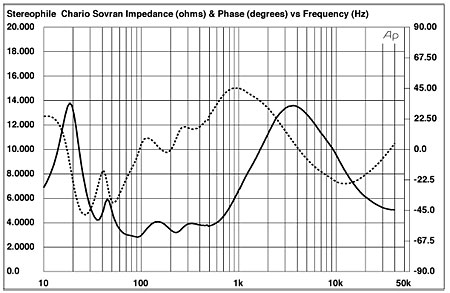
Fig.1 Chario Academy Sovran, electrical impedance (solid) and phase (dashed). (2 ohms/vertical div.)
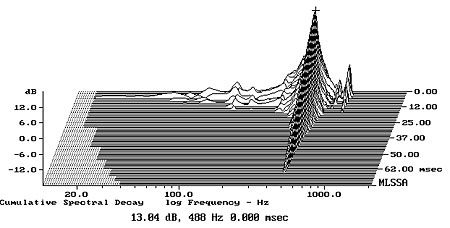
Fig.2 Chario Academy Sovran, cumulative spectral-decay plot calculated from output of an accelerometer fastened to center of head-unit side panel (MLS driving voltage to speaker, 7.55V; measurement bandwidth, 2kHz).
Chario specifies the subwoofer loading as "vented isobaric compound"; looking at fig.1, the shape of the magnitude trace below 100Hz suggests that it is a coupled-cavity type tuned to 36Hz. (The isobaric-loaded drivers fire into an internal cavity that communicates with the outside world via the vents at the bottom of the enclosure side panels.) The red trace in fig.3 shows the subwoofer's output, measured in the nearfield. It comprises a bandpass response peaking in the octave between 40 and 80Hz, with a 24dB/octave, fourth-order rolloff below that region and an initially slower rolloff above it. While some upper-frequency modes are present in its output—always a problem with coupled-cavity loading—these are well down in level.
Turning to the head-unit, the woofer's nearfield output is shown in blue in fig.3, that of the rear-facing port (which was stuffed with foam) in green. Called by Chario a "back-firing slot with aperiodic loading," this tuning is not a classic reflex alignment. There is no minimum-motion notch in the woofer's output, the port's output peaks at the same frequency as the woofer's, and the outputs of the woofer and port appear to be in phase below the port resonance—all of which suggest that the woofer's loading is more akin to a transmission-line. Note the broad overlap between the mid/woofer and the subwoofer, which, as MF points out, is deliberate.
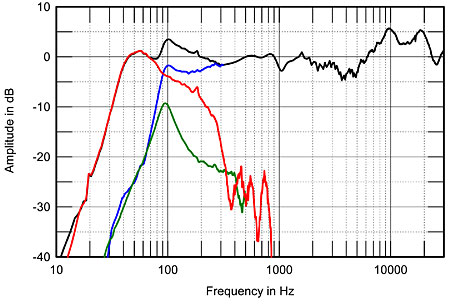
Fig.3 Chario Academy Sovran, anechoic response on tweeter axis at 50" without grille (black), averaged across 30° horizontal window and corrected for microphone response, with the nearfield responses of woofer (blue), head-unit port (green), and subwoofer (red), plotted in the ratios of the square roots of their radiating areas below 300Hz, 500Hz, and 850Hz, respectively, and the complex sum of nearfield responses plotted below 300Hz (black).
Higher in frequency in fig.3, the integration of the woofer and tweeter outputs on the tweeter axis is not quite optimal, this indicated by a lack of energy between 3 and 6kHz. All things being equal, this would give the Sovran's balance a very slightly polite character. However, the top two octaves rise by 6dB or so above the midrange reference level.1 I would have thought this boost to be too high in frequency to be perceived as "bright," though MF did characterize the Sovran's balance as having "a slight tilt toward brightness." He also remarked on the speaker's "exceptional resolution of high-frequency detail" and its highs as being "on the airy, exuberant side," both of which would also result from this measured behavior. The rather clunky grille introduced +3/–6dB irregularities in the Sovran's tweeter-axis response (fig.4); I recommend leaving them off for serious auditioning.
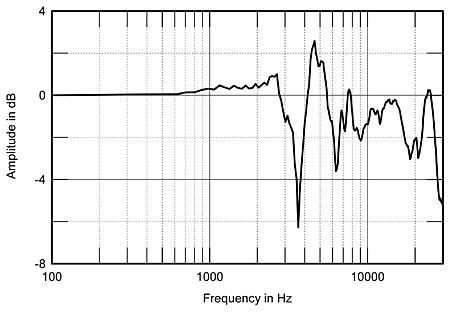
Fig.4 Chario Academy Sovran, effect of grille on the tweeter-axis response.
The Sovran's lateral dispersion (fig.5) is quite even, but there is a touch of off-axis flare at the bottom of the tweeter's passband, between 3 and 5kHz, that will tend to compensate for the lack on on-axis energy in the same region but might add a touch of brightness in lively rooms. As I would have expected from the tweeter's large diameter, its dispersion narrows rapidly above 10kHz, which will work against the audibility of the Chario's top-octave plateau on the tweeter axis. In the vertical plane (fig.6), the response doesn't change by a large amount above or below the tweeter axis, which is 35" from the floor. However, the lack of presence-region energy on the tweeter axis does tend to fill in for listeners who sit higher or lower than that.
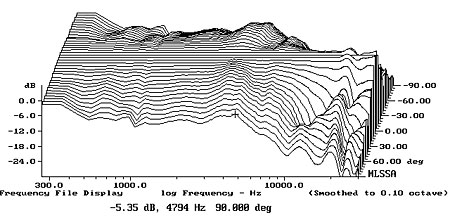
Fig.5 Chario Academy Sovran, lateral response family at 50", normalized to response on tweeter axis, from back to front: differences in response 90–5° off axis, reference response, differences in response 5–90° off axis.
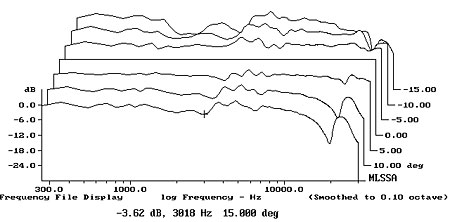
Fig.6 Chario Academy Sovran, vertical response family at 50", normalized to response on tweeter axis, from back to front: differences in response 15–5° above axis, reference response, differences in response 5–15° below axis.
Fig.7 shows how all these quasi-anechoic measurements added up in MF's listening room, with the speakers driven by the Musical Fidelity kW monoblocks. As usually results from the speaker positions Mikey is forced to use, which are fairly close to the room's corners, the midbass region is elevated, with a corresponding lack of upper-bass energy. The lows do usefully extend to 30Hz, however. A slight excess of energy in-room in the middle of the midrange will reduce soundstage depth, but the treble is very flat up to 6kHz, above which the on-axis boost makes its presence known.
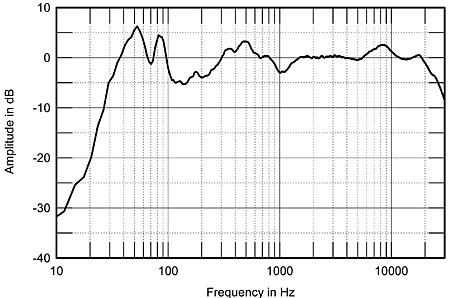
Fig.7 Chario Academy Sovran, spatially averaged, 1/6-octave response in MF's listening room.
Turning to the time domain, the Sovran's step response on the tweeter axis is shown in fig.8. The tweeter and mid/woofer are connected in positive acoustic polarity, the subwoofer in inverted polarity. The woofer's output arrives a little late on this axis to integrate properly with the decay of the tweeter's step—inevitable, given the tiltback of the front baffle and the fact that the tweeter is mounted below the mid/woofer—which results in the lack of presence-region energy seen in the on-axis frequency response. The cumulative spectral-decay plot on the tweeter axis (fig.9) is superbly clean overall.
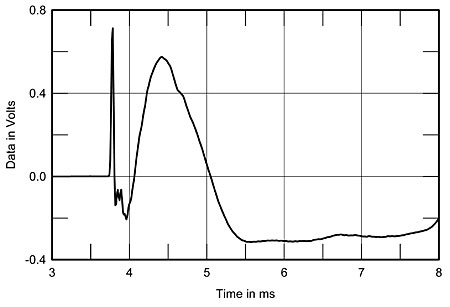
Fig.8 Chario Academy Sovran, step response on tweeter axis at 50" (5ms time window, 30kHz bandwidth).
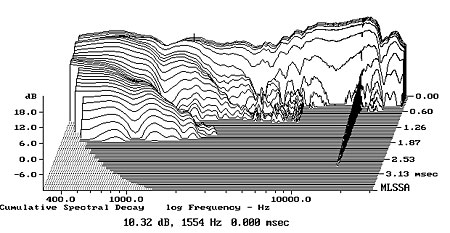
Fig.9 Chario Academy Sovran, cumulative spectral-decay plot on tweeter axis at 50" (0.15ms risetime).
While some aspects of the Chario Academy Sovran's design puzzled me a little, overall it performed very well on the test bench.—John Atkinson
Footnote 1: In this respect, the Sovran is very similar to Chario's earlier Academy One, reviewed by Larry Greenhill in March 1998.—John Atkinson
